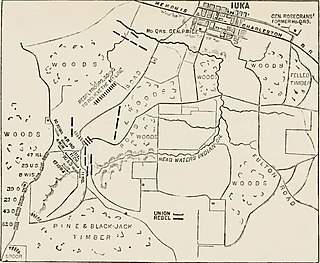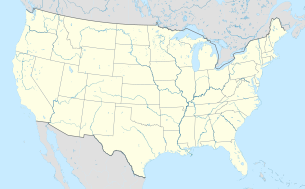
Prestonsburg is a small home rule-class city in and the county seat of Floyd County, Kentucky, United States. It is in the eastern part of the state in the valley of the Big Sandy River. The population was 3,255 at the time of the 2010 census, down from 3,612 at the 2000 census.

The Battle of New Market was fought on May 15, 1864, in Virginia during the Valley Campaigns of 1864 in the American Civil War. A makeshift Confederate army of 4,100 men defeated the larger Army of the Shenandoah under Major General Franz Sigel, delaying the capture of Staunton by several weeks.

The Battle of Stones River, also known as the Second Battle of Murfreesboro, was a battle fought from December 31, 1862, to January 2, 1863, in Middle Tennessee, as the culmination of the Stones River Campaign in the Western Theater of the American Civil War. Of the major battles of the war, Stones River had the highest percentage of casualties on both sides. The battle ended in Union victory after the Confederate army's withdrawal on January 3, largely due to a series of tactical miscalculations by Confederate General Braxton Bragg, but the victory was costly for the Union army. Nevertheless, it was an important victory for the Union because it provided a much-needed boost in morale after the Union's recent defeat at Fredericksburg and also reinforced President Abraham Lincoln's foundation for issuing the Emancipation Proclamation, which ultimately discouraged European powers from intervening on the Confederacy's behalf.

The Battle of Fort Henry was fought on February 6, 1862, in Stewart County, Tennessee, during the American Civil War. It was the first important victory for the Union and Brig. Gen. Ulysses S. Grant in the Western Theater.

The Battle of Perryville, also known as the Battle of Chaplin Hills, was fought on October 8, 1862, in the Chaplin Hills west of Perryville, Kentucky, as the culmination of the Confederate Heartland Offensive during the American Civil War. Confederate Gen. Braxton Bragg's Army of Mississippi initially won a tactical victory against primarily a single corps of Maj. Gen. Don Carlos Buell's Union Army of the Ohio. The battle is considered a strategic Union victory, sometimes called the Battle for Kentucky, since Bragg withdrew to Tennessee soon thereafter. The Union retained control of the critical border state of Kentucky for the remainder of the war.

The Battle of Williamsburg, also known as the Battle of Fort Magruder, took place on May 5, 1862, in York County, James City County, and Williamsburg, Virginia, as part of the Peninsula Campaign of the American Civil War. It was the first pitched battle of the Peninsula Campaign, in which nearly 41,000 Federals and 32,000 Confederates were engaged, fighting an inconclusive battle that ended with the Confederates continuing their withdrawal.

The Battle of Cross Keys was fought on June 8, 1862, in Rockingham County, Virginia, as part of Confederate Army Maj. Gen. Thomas J. "Stonewall" Jackson's campaign through the Shenandoah Valley during the American Civil War. Together, the battles of Cross Keys and Port Republic the following day were the decisive victories in Jackson's Valley Campaign, forcing the Union armies to retreat and leaving Jackson free to reinforce Gen. Robert E. Lee for the Seven Days Battles outside Richmond, Virginia.

The Battle of Jackson, also known as the Battle of Salem Cemetery, was fought on December 19, 1862, in Madison County, Tennessee, during the American Civil War.
The First Battle of Murfreesboro was fought on July 13, 1862, in Rutherford County, Tennessee, as part of the American Civil War. Troops under Confederate cavalry commander Brig. Gen. Nathan Bedford Forrest surprised and quickly overran a Federal hospital, the camps of several small Union units, and the jail and courthouse in Murfreesboro, Tennessee. All of the Union units surrendered to Forrest, and the Confederates destroyed much of the Union's supplies and destroyed railroad track in the area. The primary consequence of the raid was the diversion of Union forces from a drive on Chattanooga.

The Battle of Mill Springs, also known as the Battle of Fishing Creek in Confederate terminology, and the Battle of Logan's Cross Roads in Union terminology, was fought in Wayne and Pulaski counties, near current Nancy, Kentucky, on January 19, 1862, as part of the American Civil War. The Union victory concluded an early Confederate offensive campaign in south central Kentucky.

The Battle of Munfordville was an engagement in Kentucky during the American Civil War. Victory there allowed the Confederates to temporarily strengthen their hold on the region and impair Union supply lines.

The Battle of Old Church, also known as Matadequin Creek, was fought on May 30, 1864, as part of Union Lt. Gen. Ulysses S. Grant's Overland Campaign against Confederate Gen. Robert E. Lee's Army of Northern Virginia during the American Civil War.

The Battle of Iuka was fought on September 19, 1862, in Iuka, Mississippi, during the American Civil War. In the opening battle of the Iuka-Corinth Campaign, Union Maj. Gen. William Rosecrans stopped the advance of the Confederate Army of the West commanded by Maj. Gen. Sterling Price.

The Big Sandy Expedition was an early campaign of the American Civil War in Kentucky that began in mid-September 1861 when Union Brig. Gen. William "Bull" Nelson received orders to organize a new brigade at Maysville, Kentucky and conduct an expedition into the Big Sandy Valley region of Eastern Kentucky and stop the build-up of Confederate forces under Col. John S. Williams. This was done in three phases. From September 21 to October 20, 1861, Nelson assembled a brigade of 5,500 Union volunteers from Ohio and Kentucky. On October 23, the southern prong secured Hazel Green and the northern prong West Liberty. The two prongs were consolidated at Salyersville and they began the final phase on October 31. This led to the Battle of Ivy Mountain on November 8 and the withdrawal of Confederate forces from Pikeville (Piketon) on November 9, 1861.
The Battle of Griswoldville was the first battle of Sherman's March to the Sea, fought November 22, 1864, during the American Civil War. A Union Army brigade under Brig. Gen. Charles C. Walcutt fought three brigades of Georgia militia under Brig. Gen. Pleasant J. Philips, at Griswoldville, near Macon, Georgia, and continued its march toward Savannah.

The Battle of Buck Head Creek was the second battle of Sherman's March to the Sea, fought November 28, 1864, during the American Civil War. Union Army cavalry under Brig. Gen. Hugh Judson Kilpatrick repulsed an attack by the small Confederate cavalry corps under Maj. Gen. Joseph Wheeler, but abandoned its attempt to destroy railroads and rescue Union prisoners of war.

Humphrey Marshall was an American lawyer, politician, and military official from Kentucky. During the Antebellum era, he served four terms in the United States House of Representatives, interrupted by a brief stint as ambassador to China. When the American Civil War broke out, he sided with the Confederacy, becoming a brigadier general in the CS Army and then a Confederate Congressman.
The 14th Kentucky Infantry Regiment was an infantry regiment that served in the Union Army during the American Civil War.
The Battle of Camp Wildcat was one of the early engagements of the American Civil War. It occurred October 21, 1861, in northern Laurel County, Kentucky during the campaign known as the Kentucky Confederate Offensive or Operations in Eastern Kentucky (1861). The battle is considered one of the first Union victories of the Civil War, and marked the second engagement of troops in the Commonwealth of Kentucky.























